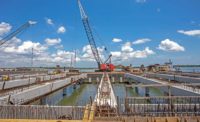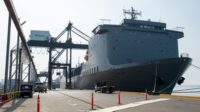“Let’s deliver Louisiana’s future together,” said Brandy D. Christian, president and CEO of Port NOLA and CEO of New Orleans Public Belt Railroad, during the 2022 State of the Port address Sept. 29 at The New Orleans Marriott on Canal Street. This was the first annual address since 2019.
Because of completed projects, others in progress and those planned, the Port of New Orleans is well positioned to be a leader in global trade, she said. A multi-modal deep-water port, Port NOLA provides access to major inland hubs such as Dallas, Memphis, Chicago and Canada through 14,500 miles of connecting waters, railroads and interstate highways. Four components provide revenues: cargo, rail, real estate and the cruise industry.
Two massive infrastructure projects securely root Christian’s optimism: the upgraded levee system and the deepening of the Mississippi River in the area, both completed by the U.S. Army Corp of Engineers.
For one, the Hurricane a d Storm Damage Risk Reduction System is designed to provide protection against 100-year flood events. During the last 10 years, the $14.6-billion HSDRRS has strengthened levees, floodwalls, gated structures and pump stations within the 133–mile Greater New Orleans perimeter system and improved approximately 70 miles of interior risk-reduction structures.
And, this summer, USACE completed the second of two phases for the $250-million 50-ft deepening of the river from Southwest Pass to the Port of New Orleans. “This was a big win in the decades-long push to deepen the Mississippi River,” Christian said following the address. Weeks Marine and Manson Construction Co., both based in Houma, La., combined to dredge the first phase.
“It’s a transformational project that will harness our greatest natural resource — the Mississippi River — for the future of our trade-based economy,” she explained. “A deeper river is essential for the future of competitive container business in the state of Louisiana.”
Christian added: “But to truly take advantage of that we will require long-term investment in our port infrastructure.” Some of this funding, in fact, came out of the 2022 Louisiana Legislative Session, when Port NOLA secured approximately $96.6 million for regional infrastructure projects to increase international trade, create new jobs and stimulate development.
In August 2021, the $2-million Lineage Logistics Cold Storage facility at Jourdan Road was completed, supporting the state’s $1.6-billion poultry industry while creating approximately 50 maritime and warehousing jobs.
Also last year, in December, the port received four new 100-foot gantry cranes and extended the length and gauge of the crane rail as the first of three expansion phases at the estimated $143.7-million Napoleon Avenue Container Terminal project, she explained. Boos Navarre LLC designed and managed the gantry crane construction and commissioning, AECOM designed the project and Volkert Inc. managed the construction phases.
Orion Industrial Construction, Houston, was the prime contractor for the wharf reconstruction, and Metairie, La.-based Centric Gulf Coast Inc. was the prime contractor for the electrical work. Two of the four cranes are operational, and Christian said that the remaining two are expected to be on line by the end of this year.
The phase 2 Priority Enhancements Project is a $10.23-million investment scheduled for completion by the end of 2022. The third phase, representing $21.5 million, includes the Terminal Complex Modernization Program. These two phases include adding 200 electrified plugs to handle additional refrigerated container cargo, a new empty-container gate complex and the reconstruction and strengthening of 15 acres of heavy-duty concrete paving to expand loaded container storage capacity, among other items, Christian said.
In December 2020, the Port of New Orleans purchased property in Violet for the site of the Louisiana International Terminal. The anticipated start of the mega-project is 2025, with the first berth scheduled to open in 2028. “We are still in the very early phase of the two- to three-year federal permitting process. Procurement opportunities will increase as that moves forward,” she added.
“The new terminal will have a profound impact on the state of Louisiana and the region,” Christian explained, citing 12,000 new direct and indirect jobs, $800 million in additional state tax revenue, $200 million to St. Bernard Parish and approximately a 15% increase in personal income in St. Bernard Parish by 2050. “That’s not to mention the real opportunities the terminal will provide to attract distribution centers, logistics services and value-added services,” she added.
Christian also said that Port NOLA is investing in major maintenance and resiliency projects to keep the wharves, sheds, bridges and cyber infrastructure working at optimum levels.
Looking forward, Port NOLA, as a major landowner and investor in St. Bernard Parish, is advocating for transportation improvements that will serve both the LIT and the community, she explained.
One envisioned project is the St. Bernard Transportation Corridor, an elevated public roadway to connect Lower St. Bernard Parish with the interstate system. “It will serve terminal-related truck traffic, support St. Bernard population growth, attract and retain industry and provide an alternate hurricane-evacuation route for residents,” Christian said, noting that the Legislature has committed $50 million in Capital Outlay funds for its planning, design and engineering.
Opportunities to bid on the LIT will be publicized; contractors and other vendors can stay informed at portnola.com/business/procurement.




Post a comment to this article
Report Abusive Comment